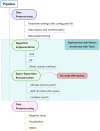Comprehensive framework of GPU-accelerated image reconstruction for photoacoustic computed tomography
- PMID: 38846677
- PMCID: PMC11155389
- DOI: 10.1117/1.JBO.29.6.066006
Comprehensive framework of GPU-accelerated image reconstruction for photoacoustic computed tomography
Abstract
Significance: Photoacoustic computed tomography (PACT) is a promising non-invasive imaging technique for both life science and clinical implementations. To achieve fast imaging speed, modern PACT systems have equipped arrays that have hundreds to thousands of ultrasound transducer (UST) elements, and the element number continues to increase. However, large number of UST elements with parallel data acquisition could generate a massive data size, making it very challenging to realize fast image reconstruction. Although several research groups have developed GPU-accelerated method for PACT, there lacks an explicit and feasible step-by-step description of GPU-based algorithms for various hardware platforms.
Aim: In this study, we propose a comprehensive framework for developing GPU-accelerated PACT image reconstruction (GPU-accelerated photoacoustic computed tomography), to help the research community to grasp this advanced image reconstruction method.
Approach: We leverage widely accessible open-source parallel computing tools, including Python multiprocessing-based parallelism, Taichi Lang for Python, CUDA, and possible other backends. We demonstrate that our framework promotes significant performance of PACT reconstruction, enabling faster analysis and real-time applications. Besides, we also described how to realize parallel computing on various hardware configurations, including multicore CPU, single GPU, and multiple GPUs platform.
Results: Notably, our framework can achieve an effective rate of times when reconstructing extremely large-scale three-dimensional PACT images on a dual-GPU platform compared to a 24-core workstation CPU. In this paper, we share example codes via GitHub.
Conclusions: Our approach allows for easy adoption and adaptation by the research community, fostering implementations of PACT for both life science and medicine.
Keywords: GPU-accelerated method; Taichi Lang for Python; large-scale data size; multiple GPU platform; photoacoustic computed tomography.
© 2024 The Authors.
Figures




Similar articles
-
GPU-accelerated Double-stage Delay-multiply-and-sum Algorithm for Fast Photoacoustic Tomography Using LED Excitation and Linear Arrays.Ultrason Imaging. 2019 Sep;41(5):301-316. doi: 10.1177/0161734619862488. Epub 2019 Jul 19. Ultrason Imaging. 2019. PMID: 31322057
-
A fast forward projection using multithreads for multirays on GPUs in medical image reconstruction.Med Phys. 2011 Jul;38(7):4052-65. doi: 10.1118/1.3591994. Med Phys. 2011. PMID: 21859004
-
Graphics processing unit accelerating compressed sensing photoacoustic computed tomography with total variation.Appl Opt. 2020 Jan 20;59(3):712-719. doi: 10.1364/AO.378466. Appl Opt. 2020. PMID: 32225199
-
A survey of computational frameworks for solving the acoustic inverse problem in three-dimensional photoacoustic computed tomography.Phys Med Biol. 2019 Jul 18;64(14):14TR01. doi: 10.1088/1361-6560/ab2017. Phys Med Biol. 2019. PMID: 31067527 Review.
-
Spatial resolution in photoacoustic computed tomography.Rep Prog Phys. 2021 Mar 1;84(3). doi: 10.1088/1361-6633/abdab9. Rep Prog Phys. 2021. PMID: 33434890 Review.
Cited by
-
Iterative optimization algorithm with structural prior for artifacts removal of photoacoustic imaging.Photoacoustics. 2025 Apr 26;44:100726. doi: 10.1016/j.pacs.2025.100726. eCollection 2025 Aug. Photoacoustics. 2025. PMID: 40454259 Free PMC article.
References
-
- Xu M., Wang L. V., “Photoacoustic imaging in biomedicine,” Rev. Sci. Instrum. 77, 041101 (2006).RSINAK10.1063/1.2195024 - DOI
Publication types
MeSH terms
LinkOut - more resources
Full Text Sources
Miscellaneous

